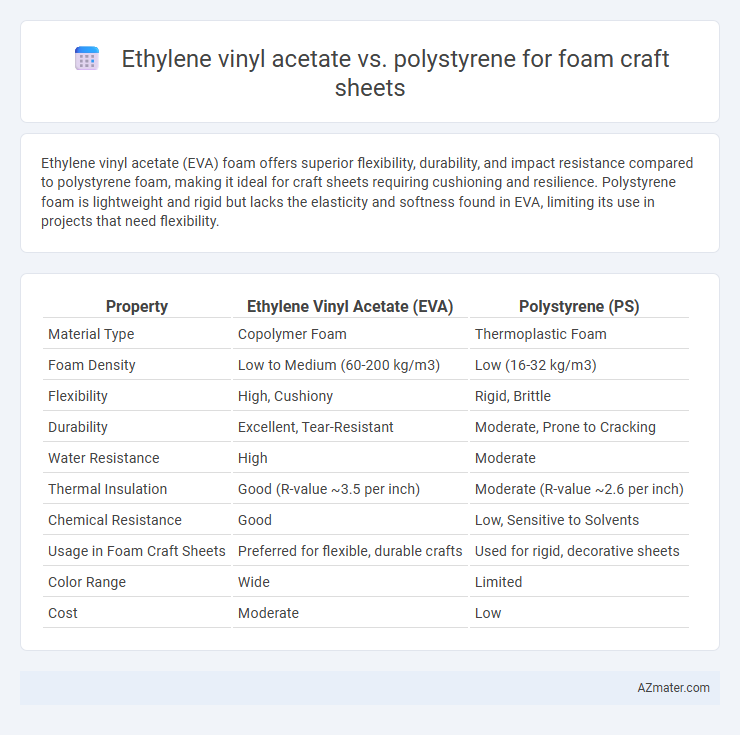Ethylene vinyl acetate (EVA) foam offers superior flexibility, durability, and impact resistance compared to polystyrene foam, making it ideal for craft sheets requiring cushioning and resilience. Polystyrene foam is lightweight and rigid but lacks the elasticity and softness found in EVA, limiting its use in projects that need flexibility.
Table of Comparison
| Property | Ethylene Vinyl Acetate (EVA) | Polystyrene (PS) |
|---|---|---|
| Material Type | Copolymer Foam | Thermoplastic Foam |
| Foam Density | Low to Medium (60-200 kg/m3) | Low (16-32 kg/m3) |
| Flexibility | High, Cushiony | Rigid, Brittle |
| Durability | Excellent, Tear-Resistant | Moderate, Prone to Cracking |
| Water Resistance | High | Moderate |
| Thermal Insulation | Good (R-value ~3.5 per inch) | Moderate (R-value ~2.6 per inch) |
| Chemical Resistance | Good | Low, Sensitive to Solvents |
| Usage in Foam Craft Sheets | Preferred for flexible, durable crafts | Used for rigid, decorative sheets |
| Color Range | Wide | Limited |
| Cost | Moderate | Low |
Introduction to Foam Craft Sheets
Foam craft sheets made from ethylene vinyl acetate (EVA) are lightweight, flexible, and provide excellent shock absorption, making them ideal for arts and crafts projects requiring durability and ease of cutting. Polystyrene foam sheets offer a rigid structure with a smooth surface, ideal for modeling, insulation, and crafts that demand a firm base. Both materials serve distinctive roles in foam crafts, with EVA prioritizing flexibility and comfort, whereas polystyrene emphasizes sturdiness and support.
Overview of Ethylene Vinyl Acetate (EVA)
Ethylene Vinyl Acetate (EVA) is a flexible, durable polymer widely used for foam craft sheets due to its excellent cushioning, high impact resistance, and resistance to stress cracking. EVA foam offers superior softness and pliability compared to Polystyrene foam, making it ideal for intricate craft projects requiring easy cutting and shaping. Its chemical stability and resistance to UV radiation enhance longevity in various crafting applications.
Overview of Polystyrene
Polystyrene foam is a rigid, lightweight material widely used in craft sheets due to its excellent insulation and structural properties. It offers high impact resistance and is easily cut, shaped, and painted, making it ideal for detailed craft projects. Compared to ethylene vinyl acetate, polystyrene provides a firmer texture and better dimensional stability, suitable for durable and precise foam craft applications.
Key Material Properties Comparison
Ethylene vinyl acetate (EVA) foam sheets offer excellent flexibility, impact resistance, and cushioning, making them ideal for crafts requiring soft, durable materials. Polystyrene foam sheets provide higher rigidity and thermal insulation but lack the elasticity and cushioning of EVA, resulting in a more brittle texture prone to cracking under stress. Key material properties highlight EVA's superior resilience and softness, while polystyrene excels in structural support and lightweight thermal performance.
Durability and Longevity
Ethylene vinyl acetate (EVA) foam sheets exhibit superior durability and longevity compared to polystyrene foam sheets due to their flexible, shock-absorbent properties and resistance to cracking or crumbling over time. EVA foam maintains structural integrity under repeated bending and handling, making it ideal for long-term craft projects or decorative applications. Polystyrene foam, while lightweight and inexpensive, tends to be brittle and prone to breakage, leading to a shorter lifespan in craft uses.
Workability and Crafting Ease
Ethylene vinyl acetate (EVA) foam sheets offer superior flexibility and softness, making them easier to cut, shape, and glue for intricate foam crafts compared to the rigid structure of polystyrene sheets. Polystyrene foam, while lightweight and sturdy, tends to crack or crumble during detailed cutting and requires special adhesives for effective bonding. EVA's porous surface enhances paint and glue adhesion, significantly improving overall crafting ease and versatility.
Safety and Environmental Impact
Ethylene vinyl acetate (EVA) foam sheets are non-toxic, flexible, and free from hazardous chemicals, making them safer for children's crafts and prolonged skin contact compared to polystyrene (PS) foam, which can release styrene, a possible carcinogen. EVA is more environmentally friendly as it is recyclable and produces fewer harmful emissions during manufacturing, whereas polystyrene is non-biodegradable, contributes significantly to landfill waste, and is difficult to recycle. The lower toxicity and better sustainability profile of EVA make it a preferable choice over polystyrene in foam craft applications focusing on safety and environmental impact.
Cost Efficiency Analysis
Ethylene vinyl acetate (EVA) foam sheets typically offer greater cost efficiency compared to polystyrene foam sheets due to their higher durability and flexibility, which reduces replacement frequency and material waste. Polystyrene foam sheets, while initially cheaper per unit, tend to be more brittle and less resilient, potentially leading to increased long-term expenses from breakage and limited usability in craft projects. When evaluating foam craft sheets for budget-conscious projects, EVA's balance of price and performance often results in lower overall costs despite a higher upfront price point.
Typical Uses in Crafting Projects
Ethylene vinyl acetate (EVA) foam craft sheets are widely used for projects requiring flexibility, durability, and cushioning, making them ideal for costumes, shoe insoles, and decorative crafts. Polystyrene foam sheets, while less flexible, offer excellent rigidity and insulation, commonly utilized in model making, architectural prototypes, and signage. Both materials cater to different crafting needs, with EVA favored for tactile and wearable items, and polystyrene chosen for structural and display purposes.
Choosing the Right Foam for Your Craft
Ethylene vinyl acetate (EVA) foam offers superior flexibility, durability, and water resistance compared to polystyrene foam, making it ideal for intricate craft projects requiring cushioning or flexibility. Polystyrene foam is lightweight and rigid, suitable for structural or decorative crafting where firmness and easy shaping are priorities. Choosing the right foam depends on the craft's functional needs--EVA excels in wearability and impact absorption, while polystyrene provides a stable, paintable base for creative designs.

Infographic: Ethylene vinyl acetate vs Polystyrene for Foam Craft Sheet
 azmater.com
azmater.com